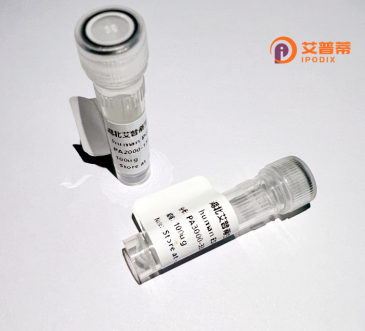
| 纯度 | >90%SDS-PAGE. |
| 种属 | Human |
| 靶点 | ARFGAP3 |
| Uniprot No | Q9NP61 |
| 内毒素 | < 0.01EU/μg |
| 表达宿主 | E.coli |
| 表达区间 | 1-516aa |
| 氨基酸序列 | MGDPSKQDIL TIFKRLRSVP TNKVCFDCGA KNPSWASITY GVFLCIDCSG SHRSLGVHLS FIRSTELDSN WSWFQLRCMQ VGGNASASSF FHQHGCSTND TNAKYNSRAA QLYREKIKSL ASQATRKHGT DLWLDSCVVP PLSPPPKEED FFASHVSPEV SDTAWASAIA EPSSLTSRPV ETTLENNEGG QEQGPSVEGL NVPTKATLEV SSIIKKKPNQ AKKGLGAKKG SLGAQKLANT CFNEIEKQAQ AADKMKEQED LAKVVSKEES IVSSLRLAYK DLEIQMKKDE KMNISGKKNV DSDRLGMGFG NCRSVISHSV TSDMQTIEQE SPIMAKPRKK YNDDSDDSYF TSSSSYFDEP VELRSSSFSS WDDSSDSYWK KETSKDTETV LKTTGYSDRP TARRKPDYEP VENTDEAQKK FGNVKAISSD MYFGRQSQAD YETRARLERL SASSSISSAD LFEEPRKQPA GNYSLSSVLP NAPDMAQFKQ GVRSVAGKLS VFANGVVTSI QDRYGS |
| 分子量 | 56.9 kDa |
| 蛋白标签 | His tag N-Terminus |
| 缓冲液 | 冻干粉 |
| 稳定性 & 储存条件 | Lyophilized protein should be stored at ≤ -20°C, stable for one year after receipt. Reconstituted protein solution can be stored at 2-8°C for 2-7 days. Aliquots of reconstituted samples are stable at ≤ -20°C for 3 months. |
| 复溶 | Always centrifuge tubes before opening.Do not mix by vortex or pipetting. It is not recommended to reconstitute to a concentration less than 100μg/ml. Dissolve the lyophilized protein in distilled water. Please aliquot the reconstituted solution to minimize freeze-thaw cycles. |
以下是关于重组人ADP核糖基化因子GTP酶活化蛋白3(ARFGAP3)的3篇参考文献及其简要摘要:
---
1. **标题**:*ARFGAP3 regulates the assembly of the Golgi apparatus and affects β-amyloid production*
**作者**:Sannerud R, et al.
**摘要**:本文发现ARFGAP3在高尔基体结构中起关键作用,其缺失导致高尔基体碎片化。此外,研究还揭示了ARFGAP3通过调节淀粉样前体蛋白(APP)的运输影响β-淀粉样蛋白(Aβ)的生成,为阿尔茨海默病的研究提供了新视角。
---
2. **标题**:*ARFGAP3 promotes breast cancer cell proliferation and invasion by activating RhoA/ROCK signaling*
**作者**:Higashitsuji H, et al.
**摘要**:研究发现ARFGAP3在乳腺癌组织中显著高表达,通过激活RhoA/ROCK信号通路促进肿瘤细胞增殖和侵袭,提示其可能成为乳腺癌治疗的潜在靶点。
---
3. **标题**:*The role of ARFGAP3 in COPI vesicle formation and Golgi-ER trafficking*
**作者**:Yahara N, et al.
**摘要**:该文献通过体外重组实验证明,ARFGAP3是COPI囊泡形成的必需因子,通过其GTP酶激活功能调控内质网-高尔基体间的膜运输,对维持细胞内蛋白质分选至关重要。
---
这些研究分别从神经退行性疾病、癌症机制及细胞运输功能三个角度探讨了ARFGAP3的多重生物学作用。
ARFGAP3 (ADP-ribosylation factor GTPase-activating protein 3) is a member of the ARFGAP family that regulates intracellular vesicular trafficking by modulating the GTPase activity of ADP-ribosylation factors (ARFs). ARFs are small GTP-binding proteins critical for vesicle formation, cargo sorting, and membrane remodeling. As a GTPase-activating protein (GAP), ARFGAP3 accelerates the hydrolysis of GTP bound to ARF proteins, switching them from an active (GTP-bound) to inactive (GDP-bound) state. This activity is essential for the uncoating of transport vesicles and membrane dynamics in secretory pathways, particularly in the Golgi apparatus and endoplasmic reticulum-Golgi transport. Structurally, ARFGAP3 contains a conserved GAP domain responsible for ARF interaction and catalytic function, along with an ALPS (amphipathic lipid-packing sensor) motif that targets curved or negatively charged membranes.
Unlike other ARFGAPs, ARFGAP3 exhibits dual functionality as both a regulator and effector in lipid metabolism and cell signaling. Studies suggest its involvement in lipid droplet formation, neuronal development, and cancer progression, with overexpression observed in certain tumors, potentially influencing cell proliferation and metastasis. Additionally, ARFGAP3 may play a role in neurodegenerative diseases, such as Alzheimer’s, by affecting β-amyloid precursor protein processing. Its interaction with coatomer proteins and sensitivity to lipid composition highlight its adaptability in diverse cellular contexts. Further research is needed to fully elucidate its molecular mechanisms and therapeutic potential.
×